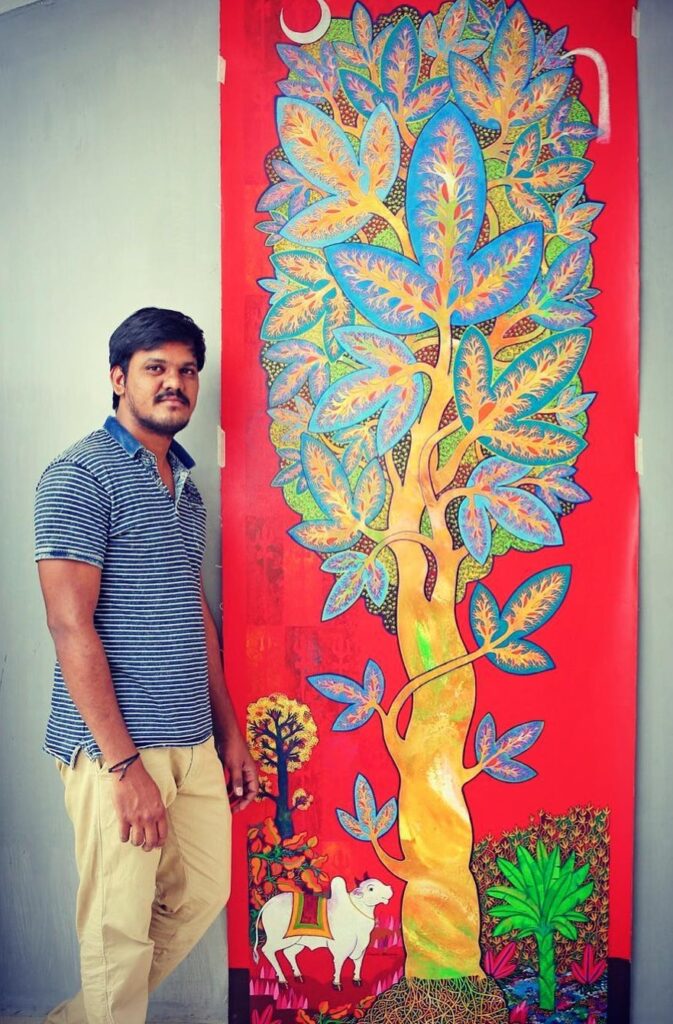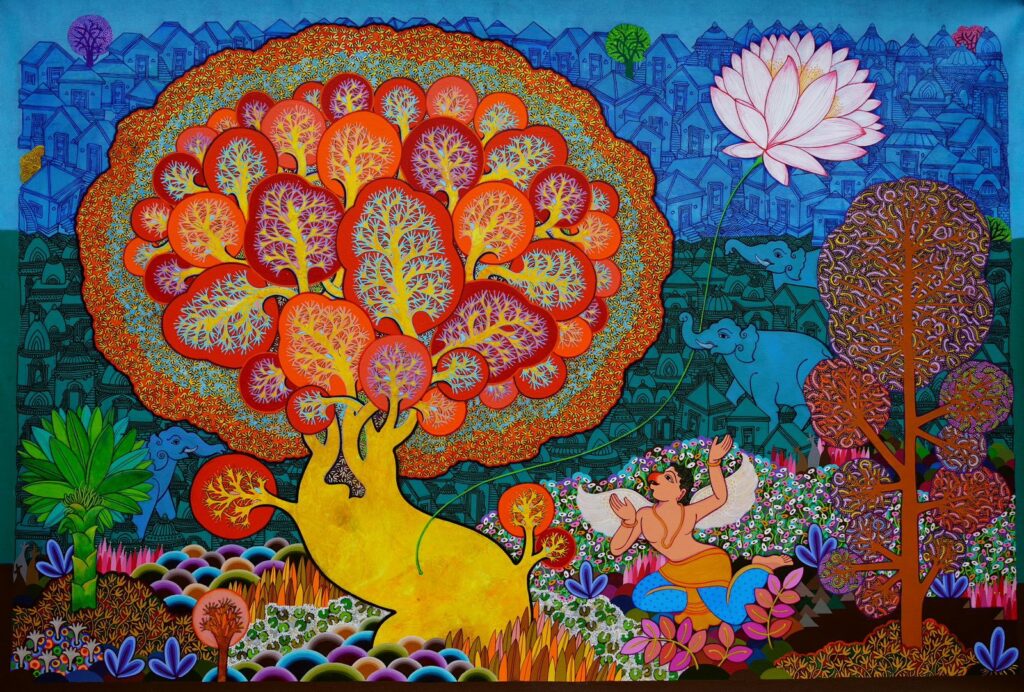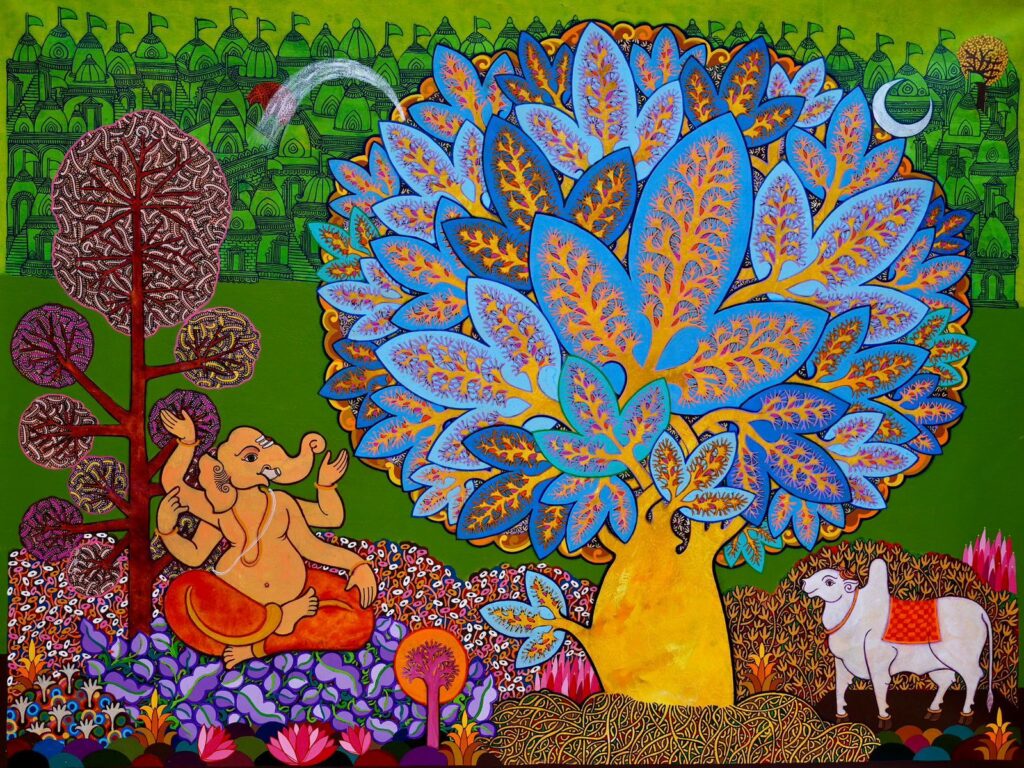UNVEILING THE MYSTIQUE :
Decoding the art of TREE OF LIFE by artist CHANDRA MORKONDA
In the vast tapestry of human creativity, art serves as a bridge between the tangible and the intangible, reflecting the depths of our imagination and the enigmas of our existence. One such masterpiece that has captivated minds and souls alike is the evocative “Tree of Life” series crafted by the visionary artist, Chandra Morkonda.
Like the branches of an ancient tree reaching for the heavens, Morkonda’s art delves into the profound, exploring the interconnectedness of all living beings and the cosmic dance of life itself. A harmonious blend of colors, forms, and symbols, these captivating artworks invite us on a journey of contemplation and self-discovery, encouraging us to seek the secrets that lie beneath their intricate surfaces.
In this blog, we embark on a quest to unlock the hidden meanings and symbolism intricately woven into each brushstroke. We’ll dive deep into the essence of the “Tree of Life” series, deciphering its philosophical underpinnings, exploring the artist’s inspirations, and gaining insights into the transformative power of art itself. Prepare to immerse yourself in a realm where nature’s wisdom meets human creativity, as we embark on an awe-inspiring exploration of Chandra Morkonda’s profound masterpiece: the Tree of Life.
About the Artist
Chandra Morkonda is a well-known Andhra Pradesh-based painter, born in 1989 in the small temple town of Srikalahasti in Chittoor District, Andhra Pradesh. He obtained his Bachelor’s Degree from JNT University in Hyderabad, and later pursued Art Masters Training from Visva Bharati University in Santiniketan.
His artistic journey reflects his experiences in the rural town of Srikalahasti, which is rich in religious and diverse cultures. Growing up in this environment, he was exposed to various faiths and totems within a religious context, with popular objects like trees and goddesses becoming prominent subjects in his art.
Chandra’s unique identity as an artist is evident in his use of vibrant colors and a tribal art-inspired style. His paintings are a direct reflection of his childhood memories of observing the bright weave patterns and hearing stories from his parents.
The theme of trees holds significant importance in Chandra’s work, particularly in his series titled “Kalpakavriksha,” which originated during his time in Santiniketan. Through his art, he interprets the beliefs, sacredness, and symbolism present in Hindu mythology, often incorporating iconic elements like Trishul, Sri-chakram, and the deity Kali.
His works project a landscape filled with symbolism and metaphors, expressing the representations of nature and goddesses as semi-divine beings in Hindu, Jain, and Buddhist pantheons, often found in places of transition from worldly to sacred spaces.
Chandra Morkonda’s art has garnered recognition and accolades, including a State Award from Potti Sree Ramulu Telugu University in Hyderabad, Andhra Pradesh. He has participated in various group shows held in cities like Delhi, Chennai, Bangalore, Kolkata, Mumbai, and Hyderabad, as well as a solo show at Forum Art Gallery in Chennai.
As an artist hailing from Andhra Pradesh, Chandra Morkonda’s vibrant and meaningful paintings continue to leave a lasting impression, showcasing the beauty and cultural richness of his homeland and reflecting his own personal journey through time and places.

LORD VISHNU - the preserver, as TREE OF LIFE

The portrayal of Vishnu as a tree in Chandra’s painting holds deep symbolic significance, representing a profound connection between the divine and the natural world. In Hindu mythology, this depiction is often associated with the concept of the “Kalpavriksha” or the “wish-fulfilling tree,” which is an integral part of the celestial realm and carries various interpretations:
Rooted in the Cosmos: Vishnu as a tree signifies the omnipresence and stability of the divine in the universe. Just as the roots of a tree anchor it to the earth, Vishnu’s divine presence extends throughout creation, providing a sense of grounding and cosmic harmony.
Nourishment and Sustenance: Trees play a vital role in sustaining life by providing oxygen, shelter, and nourishment. In this representation, Vishnu as a tree symbolizes his role as the nurturer and sustainer of the cosmos, ensuring the well-being and balance of all living beings.
Cycle of Life and Death: Trees undergo seasonal changes, shedding leaves in autumn and blossoming in spring. This cyclic nature aligns with the Hindu belief in reincarnation and the eternal cycle of birth and rebirth. Vishnu, as the preserver, oversees this process and ensures the continuity of life.
Interconnectedness: Trees are an emblem of interconnectedness among all living beings. In this context, Vishnu as a tree represents the oneness of all creation, highlighting the inherent unity that exists between humanity, nature, and the divine.
Spiritual Ascent: In some interpretations, Vishnu as a tree becomes a metaphor for spiritual growth and enlightenment. Just as a tree reaches towards the sky, seeking light and space, devotees strive to attain spiritual elevation, aiming to unite with the divine.
Symbol of Knowledge: Trees are often associated with wisdom and knowledge in various cultures. As Vishnu embodies cosmic knowledge and wisdom, this portrayal emphasizes his role as the source of divine understanding and enlightenment.
Overall, depicting Vishnu as a tree in this painting conveys a profound message about the inseparable bond between the divine and nature, encouraging a deeper appreciation for the interconnectedness of all life forms and the eternal cycle of creation and preservation. It serves as a reminder of the sacred presence that resides within every aspect of the natural world and the potential for spiritual growth and transcendence that lies within each individual.
The significance of Garuda
Garuda is a legendary bird-like creature in Hindu mythology and is depicted as a humanoid figure with the head and wings of an eagle or a falcon-like bird. In Hindu tradition, Garuda is the vahana (mount or vehicle) of Lord Vishnu, who is one of the principal deities in Hinduism and is considered the preserver and protector of the universe. Garuda is depicted as a symbol of strength, courage, and speed.
The significance of the Lotus
The lotus is intricately intertwined with Lord Vishnu in Hindu tradition. One of the most prevalent depictions of Vishnu is him resting or seated on a celestial lotus, known as the “Padma” or “Kamala.” This portrayal emphasizes Vishnu’s role as the cosmic preserver and sustainer of the universe. The lotus, emerging from murky waters untouched by impurities, represents divine purity and spiritual transcendence. It signifies Vishnu’s ability to remain untainted by the material world’s distractions and temptations, and he is often referred to as “Padmanabha,” meaning “the one with a lotus navel,” very intricately depicted in this painting.
The unfolding petals of the lotus also hold symbolic significance. They signify the process of creation and the universe’s evolution from its formless state into manifest existence. Vishnu’s association with the lotus underscores his role as the source of creation and the cosmic ocean on which the lotus blooms.
Furthermore, the lotus is linked to Goddess Lakshmi, Vishnu’s consort, who is often depicted seated on a lotus. This connection represents the harmonious union of preservation and abundance. Goddess Lakshmi, known as “Padma,” symbolizes prosperity, wealth, and well-being, and her presence alongside Vishnu on the lotus highlights their divine partnership in maintaining cosmic order and providing blessings to their devotees.
LORD SHIVA - the destroyer, as TREE OF LIFE

Similar to the depiction of Vishnu as a “Kalpavriksha” or the “wish-fulfilling tree,” the depiction of Lord Shiva as the tree also carries rich symbolic meaning, representing various aspects of his divine nature and the profound connection between the spiritual and material realms. It represents various aspects:
Regeneration and Renewal: Trees are powerful symbols of growth, regeneration, and renewal. By depicting Shiva as a tree, the painting symbolizes his role as the cosmic force that sustains the cycle of creation, preservation, and destruction. Just as a tree sheds its leaves to grow anew, Shiva’s cosmic dance, known as the “Tandava,” represents the perpetual cycle of destruction and creation in the universe.
Rooted in Transcendence: Trees have roots firmly planted in the earth while reaching upwards towards the sky. This duality represents the dual nature of Lord Shiva, who embodies both the immanent and the transcendent aspects of existence. He is the embodiment of pure consciousness and at the same time, connected to the material world.
Symbol of Immortality: Some trees are associated with immortality in various mythologies. Similarly, Lord Shiva is often seen as the eternal, timeless being beyond birth and death. By portraying him as a tree, the painting alludes to his transcendence of the temporal and his association with the infinite.
Meditation and Stillness: Trees are often seen as symbols of meditation and inner stillness. Lord Shiva, as the meditating ascetic, is frequently depicted sitting in deep contemplation. The tree representation reinforces his role as the ultimate yogi, who has achieved profound spiritual realization.
Fertility and Life Force: Trees are associated with fertility and the life force that sustains all living beings. Lord Shiva, in his aspect as the Lord of Creation and Destruction, embodies the regenerative forces of the universe and the transformative power of time.
Connection with Nature: Trees are integral to the natural world, providing sustenance, shelter, and a home for various creatures. Depicting Shiva as a tree emphasizes his close association with the natural world and the importance of maintaining harmony and balance in the ecosystem.
Sacred Knowledge: In some interpretations, trees symbolize the repository of sacred knowledge. As the embodiment of supreme wisdom and cosmic consciousness, Lord Shiva as a tree signifies the profound knowledge and spiritual wisdom that he imparts to his devotees.
Overall, the portrayal of Lord Shiva as a tree in this painting conveys a multifaceted representation of his divine attributes and cosmic significance. It serves as a reminder of the interconnectedness of the material and spiritual realms and encourages contemplation on the eternal truths of existence, the impermanence of life, and the pursuit of spiritual realization.
The significance of Nandi
Nandi is the sacred bull that serves as Lord Shiva’s mount and devoted attendant. Nandi symbolizes unwavering devotion and loyalty. Nandi is also considered a symbol of righteousness (dharma) in Hinduism. As the faithful vehicle and attendant of Lord Shiva, he exemplifies the principles of duty, righteousness, and moral conduct. His presence in this painting emphasizes the importance of single-minded devotion and surrender to the divine on the path of Dharma.
There are various myths and stories associated with Nandi in Hindu scriptures. One such legend mentions that Nandi was born from a yajna (sacred fire ritual) performed by sage Shilada to obtain a child who would be a devotee of Lord Shiva. Nandi’s mythological background adds depth and significance to his portrayal in Shiva paintings.
Besides, it adds aesthetic balance and completeness to the artwork. His form and demeanor complement the grandeur and serenity of Lord Shiva, creating a harmonious visual representation.
The significance of Lord Ganesha
Ganesha (Ganpati Bappa) is the beloved son of Lord Shiva and Goddess Parvati, and he is one of the most widely worshipped deities in the Hindu pantheon. Depiction of Ganpati holds several important meanings:
Symbol of Auspiciousness: Ganpati is often considered the remover of obstacles (Vighnaharta) and the god of new beginnings. His presence in the painting brings an auspicious and positive aura to the artwork. Including Ganpati serves to invoke blessings for a successful and obstacle-free journey for the devotee in their pursuit of spirituality.
Wisdom and Intelligence: Ganpati is revered as the deity of wisdom, intellect, and learning (Buddhi Deva). He is often depicted with a large head, signifying his immense wisdom and discernment. Ganpati’s presence highlights the importance of seeking knowledge and understanding in the path of spiritual growth.
Symbol of Harmony: Ganpati is depicted with an elephant’s head and a human body. This unique form represents the harmonious coexistence of different elements and the ability to see beyond apparent contradictions. This symbolizes the importance of maintaining harmony in life, recognizing the oneness in diversity, and transcending dualities.
Devotional Familial Bonds: As the son of Shiva and Parvati, Ganpati embodies pure devotion and love towards his parents. His inclusion in the painting also emphasizes the value of strong familial bonds and the significance of sincere devotion to the divine.
The significance of the Crescent
The crescent moon adorning Lord Shiva’s matted hair holds diverse symbolism in Hindu mythology. It symbolizes the passage of time, reflecting the cyclical nature of existence. Shiva’s calm and serene demeanor is mirrored in the moon’s tranquil glow. Additionally, the crescent moon is linked to the activation of Shiva’s powerful third eye, representing the destruction of ignorance and the awakening of higher consciousness. Another interpretation associates it with Shiva’s compassion, as he offered a place to the moon, cursed by Daksha, on his head. The crescent of Shiva embodies the divine interplay of time, nature, and spirituality, adding to the enigmatic allure of the deity in Hindu traditions.
The significance of the river Ganga
The depiction of the Ganga river flowing from Lord Shiva’s hair is a significant and iconic representation in Hindu mythology and art. This portrayal is associated with the legend of the descent of the Ganges (Ganga Avatara) from the heavens to Earth.
In Hindu mythology, the Ganges is a sacred river personified as the goddess Ganga. According to the legend, the celestial river was brought down to Earth by Lord Shiva to alleviate the suffering of humanity. As the story goes, King Bhagiratha performed intense penance to request Lord Shiva’s help in releasing the Ganges from the heavens to cleanse the ashes of his ancestors and grant them salvation. Impressed by Bhagiratha’s devotion, Lord Shiva agreed and captured the mighty river in his tangled hair to prevent its powerful force from flooding the Earth. Gradually, he released the Ganges in a controlled stream through his matted locks, allowing it to gently flow to the mortal realm.
The depiction of the Ganga river in Shiva’s hair symbolizes the divine interplay of cosmic forces and the significance of the sacred Ganges in Indian culture. This portrayal is a potent reminder of Lord Shiva’s role as the benevolent protector and bestower of blessings upon humanity. Additionally, it reinforces the sanctity of the Ganges, which holds immense spiritual and cultural importance to millions of people in India and beyond.
LORD BRAHMA - the creator, as TREE OF LIFE
Brahma, the creator in Hindu mythology, is one of the Trimurti, the three primary deities responsible for the creation, preservation, and destruction of the universe. As the creator, Brahma holds a crucial role in the cosmic cycle known as “Srishti” (creation).
According to Hindu cosmology, before the creation of the universe, there was nothing but darkness and formless chaos. Brahma emerged from a cosmic golden egg, known as Hiranyagarbha or the “Golden Womb,” and he is said to have created the universe out of this primordial essence.
Brahma is typically depicted with four faces, each representing one of the four Vedas (sacred scriptures in Hinduism) – Rigveda, Yajurveda, Samaveda, and Atharvaveda. He is also depicted with four hands, symbolizing the four directions and the four aspects of human existence – mind, intellect, ego, and consciousness.
After the initial creation, Brahma is believed to have given birth to various deities, sages, and celestial beings. He created the Devas (celestial gods), who are responsible for maintaining order and harmony in the universe.
According to some accounts, Brahma is credited with the creation of the first human beings. In Hindu mythology, there are different stories about the creation of humans, and one of them involves Brahma creating the first humans named Manu and Shatarupa.
In some spiritual and mythological traditions, the concept of the “Tree of Life” is associated with Brahma, the Hindu god of creation. However, it’s essential to clarify that the more widely known representation of the “Tree of Life” in Hinduism is not directly linked to Brahma but rather to a different concept called “Kalpavriksha.” Although, as Chandra Morkonda paints Brahma as a Tree of Life, it is rather a Tree of Creation, playing a vital role in shaping the cosmos and life as we know it.
Conclusion - THE TRIMURTI
Chandra’s essence of the series of Tree of Life is magestically based on the concept of the Trimurti!
The trio of Brahma, Vishnu, and Shiva (also known as Mahesh) form the Trimurti in Hinduism, representing the three principal aspects of the divine cosmic functions. They are responsible for the creation, preservation, and destruction of the universe, respectively. To complete the description:
Brahma: The Creator – As mentioned earlier, Brahma is responsible for the creation (Srishti) of the universe and all living beings. He is associated with the aspect of creation and is depicted with four heads and four hands.
Vishnu: The Preserver – Vishnu is the second aspect of the Trimurti and is responsible for the preservation (Sthiti) of the universe. He is believed to sustain and maintain order in the cosmos. Vishnu is known for his avatars, particularly Lord Rama and Lord Krishna, who descend to the earthly realm whenever there is a need to restore balance and righteousness.
Shiva (Mahesh): The Destroyer – Shiva, also known as Mahesh, is the third aspect of the Trimurti and is responsible for the destruction (Samhara) of the universe. However, it’s essential to understand that the destruction aspect is not merely about causing harm but rather about transformation and renewal. Shiva’s role as the destroyer paves the way for new creation and change.
Together, Brahma, Vishnu, and Shiva represent the cyclical nature of existence, where creation arises, is sustained for a time, and eventually undergoes dissolution, only to be recreated again. This cycle is known as the cosmic dance or “Tandava,” where Shiva’s dance symbolizes the eternal rhythm of creation, preservation, and destruction in the universe.
We hope you enjoy his work as much as we do! You can always contact us to source and customise his paintings… Or, check out the web store in the Paintings Tab!

